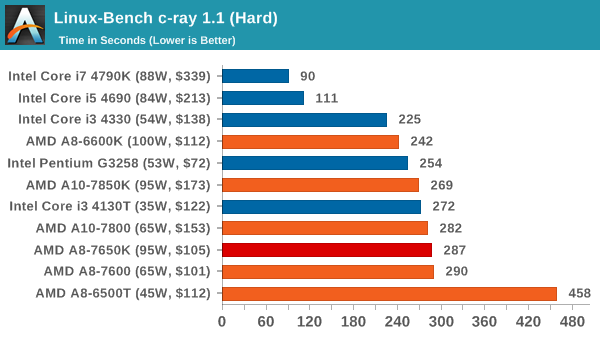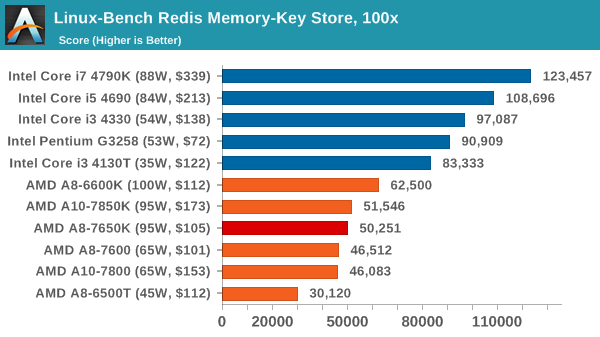The AMD A8-7650K APU Review, Also New Testing Methodology
by Ian Cutress on May 12, 2015 10:00 AM ESTProfessional Performance: Linux
Built around several freely available benchmarks for Linux, Linux-Bench is a project spearheaded by Patrick at ServeTheHome to streamline about a dozen of these tests in a single neat package run via a set of three commands using an Ubuntu 11.04 LiveCD. These tests include fluid dynamics used by NASA, ray-tracing, OpenSSL, molecular modeling, and a scalable data structure server for web deployments. We run Linux-Bench and have chosen to report a select few of the tests that rely on CPU and DRAM speed.
C-Ray: link
C-Ray is a simple ray-tracing program that focuses almost exclusively on processor performance rather than DRAM access. The test in Linux-Bench renders a heavy complex scene offering a large scalable scenario.

Being a scaling benchmark, C-Ray prefers threads and seems more designed for Intel.
NAMD, Scalable Molecular Dynamics: link
Developed by the Theoretical and Computational Biophysics Group at the University of Illinois at Urbana-Champaign, NAMD is a set of parallel molecular dynamics codes for extreme parallelization up to and beyond 200,000 cores. The reference paper detailing NAMD has over 4000 citations, and our testing runs a small simulation where the calculation steps per unit time is the output vector.

NAMD is similar to our office benchmarks, puttin the bulk of the APUs between the i3-4130T and the i3-4330.
NPB, Fluid Dynamics: link
Aside from LINPACK, there are many other ways to benchmark supercomputers in terms of how effective they are for various types of mathematical processes. The NAS Parallel Benchmarks (NPB) are a set of small programs originally designed for NASA to test their supercomputers in terms of fluid dynamics simulations, useful for airflow reactions and design.

Despite the rated memory on the APUs being faster, NPB seems to require more IPC than DRAM speed.
Redis: link
Many of the online applications rely on key-value caches and data structure servers to operate. Redis is an open-source, scalable web technology with a b developer base, but also relies heavily on memory bandwidth as well as CPU performance.











177 Comments
View All Comments
Sejong - Tuesday, May 12, 2015 - link
No comments. That just states AMD`s current position.bumble12 - Tuesday, May 12, 2015 - link
Well, if you post a minute or two after the review goes live, what might you expect exactly?YuLeven - Tuesday, May 12, 2015 - link
I think you'll find that he said "no comments" as in "no comments about AMD's poor performance", not as in "there aren't comments on this review" pal.anandreader106 - Tuesday, May 12, 2015 - link
....not sure if serious....or trolling....DevilSlayerWizard - Tuesday, May 12, 2015 - link
I would prefer if AMD made a quad core Zen with ''atleast'' 1024 GCN cores, whatever memory subsystem needed to feed the chip including RAM and motherboard for less than 500$ in 2016. Pretty reasonable if you ask me.barleyguy - Tuesday, May 12, 2015 - link
The PS4 processor, which AMD makes, is an R9-280 with an 8 core CPU. The problem is that it would be memory limited quite badly on a PC motherboard. In the PS4 it's paired with very fast memory.Possibly when AMD goes to DDR4 their APUs will start to shine, and they'll have the memory bandwidth to go wider on the GPU.
extide - Tuesday, May 12, 2015 - link
No, it's not. It is roughly between an R7 265 and R9 270 -- not anywhere near an R9 280.ravyne - Tuesday, May 12, 2015 - link
Its not a 280 -- Its got 20 GPU clusters only for 1280 shader lanes, two clusters are there for yield purposes and 4 more are dedicated to compute tasks. It has only 896 shaders dedicated to graphics, and and 256 for compute (though some engines leverage compute during rendering, so the line is a bit fuzzy). The PS4 has a 512bit memory bus, which is really wide for the GPU power, but its also feeding CPU compute. Its got 8 ACES like the 290/X.The 280 fully unlocked has 32 clusters for 2048 shaders. A 280/X has a 256bit GDDR5 bus, and only 2 ACES.
What's in the PS4 is also custom-extended beyond any retail GPU, but the closest thing would be like a Hawaii (290/X) or Tonga (285), but cut down to 18 clusters.
Revdarian - Wednesday, May 13, 2015 - link
The ps4 doesn't have 256 shaders for compute only, it has 1280 shaders total and that is it, how you decide to divide the workload for your engine is up to you, what you are thinking of was totally taken out of the context of it being an example of how to use the tools provided to the developers.nikaldro - Saturday, May 16, 2015 - link
Ps4 has 1152